Terebess
fűszerkalauz
«
vissza a Terebess Online nyitólapjára
«
vissza a Kertek
és konyhák indexlapra
Argentína
Yerba
mate - Maté
tea
Más
néven: matétea, jezsuita-tea, missziós-tea, Paraguay-tea, Szent Bertalan-tea,
yerba
maté, erva
mate, congonha, erveira, Paraguay cayi, Paraguay tea, South American holly, matéteestrauch,
erva-verdadeira, St. Bartholomew’s tea, Jesuit’s tea, hervea, caminú, kkiro, kali
chaye
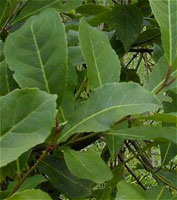
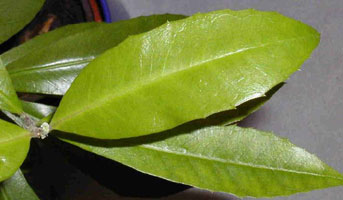
Ilex
paraguariensis
A
maté a magyalfélék családjába (Aquifoliaceae) tartozó, habitusában a magyalra
emlékeztető trópusi-szubtrópusi örökzöld növény. Dél-Amerikában őshonos fafaj,
a déli szélesség 10° és 30° között nő a Paraná és a Paraguay folyók medencéjében.
Környezeti igényeit tekintve évi 1500 mm csapadékot és 15-17°C átlaghőmérsékletet
kíván. Magassága elérheti a 7-15 métert. Termése küllemben a bors termésére hasonlít.
Tudományos
nevét - Ilex paraguariensis - a francia botanikustól Auguste de Saint Hilaire-től
kapta 1822-ben.
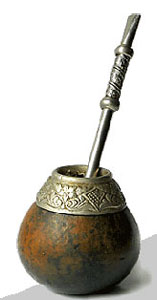
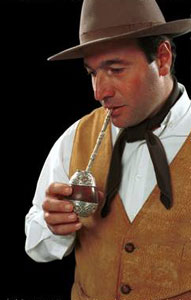
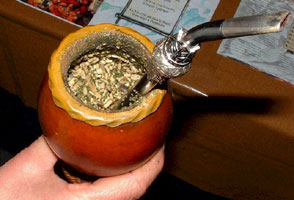
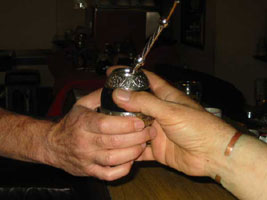
servir
el mate, maté
teázás tökhéjcsészéből szívókanállal
Szárított leveleit, szárait teaként fogyasztják főként Argentínában, Dél-Brazíliában, Uruguayban és Paraguayban. Számunkra nagynak tűnő, fél- vagy egykilós kiszerelésben árusítják. A főzet zöldes színű, a teához hasonlóan koffein és tannin tartalmú élénkítő ital, de kevésbé fanyar.
A koffeinnel csaknem azonos mennyiségű mateint tartalmaz, ezenkívül 146-féle(!) illóolajféleséget, ásványi anyagokat, nyomelemeket, csersavat és rengeteg vitamint. Erősíti az immunrendszert, csökkenti a stresszt, a fáradtság- és éhségérzetet, segíti az emésztést, ellazítja az izmokat, lassítja az öregedést, frissíti az agytevékenységet, a vérkeringést, segíti a szívműködést, méregtelenít, szabályozza a vércukorszintet.
Európa a jezsuita misszionáriusok közvetítésével - Amerika felfedezése után - találkozott először a matéval. Innen erednek a maté-tea további elnevezései is: jezsuita-tea, missziós-tea. A misszionáriusok megfigyelték, hogy a guarani indiánok rendkívül sokat fogyasztanak egy bizonyos növény főzetéből. Érdekesnek tartották azt is, hogy bár az indiánok étrendje jóformán csak húsból állt - az európai tengerészekhez hasonlóan -, az indiánok számára a skorbut mégis ismeretlen betegség volt. A maté szó a kecsua "matí" szóból származik. Azt a lopótököt (Lagenaria vulgaris) nevezték így az indiánok, melyből mai napig szokás a maté-teát fogyasztani.
A Paraguayban és Brazília déli részén vadon termő növényt a jezsuita misszionáriusok kezdték el termeszteni. Eredeti állapotában kerek koronájú fává fejlődik, művelve viszont kis termetű, ágas-bogas bokorrá alakul; kétévente szüretelhető.
A szárítás különféle módokon történhet. Brazíliában a leveles ágakat 2 m-es oldalú négyzetekben (tatacua) rendezik el a ledöngölt talajon, majd körben tüzet raknak. Az előszárított ágakat később tűz fölött hevítik, majd a megszáradt leveleket földbe ásott lyukakban törik porrá. Az így készült maté neve caa gazu vagy yerva do polos. Paraguayban és Argentína egyes részein az ágról leszedett leveleket megszárítják; ebből lesz a caa-míri nevű maté. A legjobb maté, a paraguayi caa-cuys levélrügyekből készül. Egy újabb eljárás szerint, amely a teaszárítás kínai módjára emlékeztet, a leveleket nagy öntöttvas serpenyőkben melegítik.
Matéfőzéskor a szárított levelet (yerba) szárított tökhéjba szórják, vízzel leöntik és áztatják. A tök (maté vagy culha) díszes, olykor ezüsttel berakott, sőt néha teljes egészében ezüstből van. A teát bombillával szívják ki a tökből; ez kb. 15 cm-es, többnyire ezüstből készült cső, egyik végén szűrővel, hogy a levelek ne jussanak a szájba. A matét rendszerint üresen isszák, de ízesíthetik tejjel, cukorral vagy citromlével. Jól lefedve az íze sokáig megmarad.
Az argentínok az italt is és a lopótökcsészét is maténak hívják. Hagyományosan társasági ital, körbeadják, mindenki ugyanabból a csészéből és szűrőszipkával issza. (Nem túl higiénikus, a világ többi részén talán ezért nem terjedt el.) A maté ivása otthoni szokás, nem isszák nyilvános helyen, nemigen kapható éttermekben és bárokban sem. Ha vendégségben megkínálnak, nem illik visszautasítani.
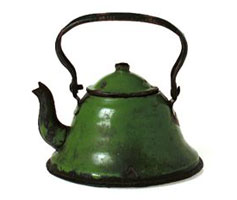
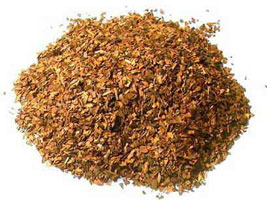
la
pava, vízforraló
kanna; la yerba mate, maté teafű
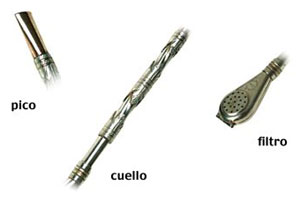

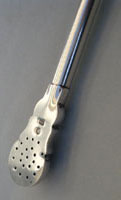
la
bombilla, a
szívókanál vagy szűrőszipka részei: pico (szopóka),
cuello (szár), filtro
(szűrő)
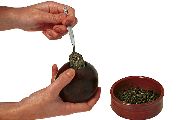
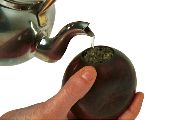
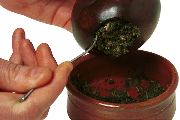
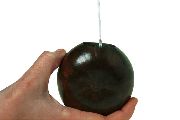
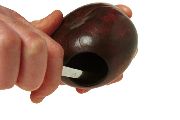
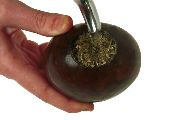
curado
del mate, a
tökhéjcsésze beavatása
Cleaning of the Mate
A very important detail is that gourd "mates" must be cleaned or cured used for the first time. The cleaning or curing eliminates the pigments of the wood that produce bad odor, and to eliminate the soft fabrics of the internal walls of the "mate". The cleaning process is simple and you can get instructions when you get a gourd mate.
How to Cure Gourd; natural gourd only.
1. Scrape the loose material out from the inside of the gourd. Leave the pointy base of the gourd intact and alone, but do remove the larger loose material.
2. Fill gourd 1/4 full with yerba mate.
3. Fill remainder of gourd with water.
4. Let it absorb water for a couple of days (unless it was used for the first day).
5. Remove water and yerba mate.
6. Re-scrape the interior loose items.
7. Dry 2-3 days under sun or near heater or until the gourd appears completely dry.
(hints and gourd care and upkeep below)
Hints:
Your goal is to cure the gourd so that the water no longer penetrates the gourd. Any natural product that takes on water is going to take on character. Do not become concerned with bubbles or color distortions, they are a natural occurrence of the curing process that will help to develop the character of your gourd.When you feel that the gourd has adequately absorbed water, that is when you may move on to step 4. It is a personal choice and should not effect performance.
You will know the gourd is dry because the inside will show no watermarks. Allowing the gourd to warm under the sun or near the heater allows the gourd to cure itself.
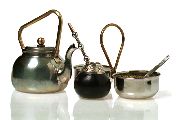
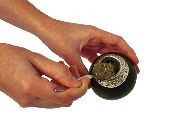
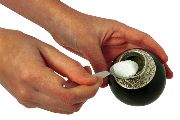
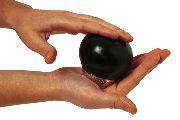
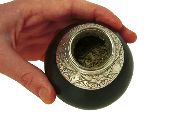
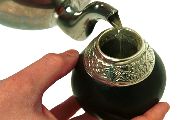
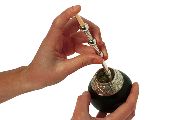
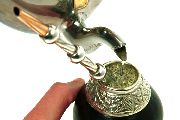
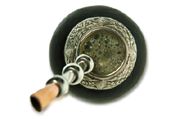
cómo
preparar (cebar) el mate, maté teafőzés
Preparation and Serving of the Mate
http://www.guayaki.com/yerbaMate/mateRitual/cureAndPack/packing/view1. Warm up the water and take away from the heat a few minutes before it starts boiling.
2. Fill 3/4 of the mate with "yerba".
3. Cover the top with your hand, turn it upside down and tap the base softly - so that the dust of the yerba (herb) stays in the surface.
4. Hold the mate in 45 degree angle and introduce the bombilla (metal straw) all the way down.
5. If you want to have a sweet mat, pour some sugar in, if not proceed to step 6.
6. Pour the hot water softly until it reaches the edge of the mate. After a few seconds, the water will be absorbed by the herb and will go down.
7. Wait a few seconds and pour some more water until the top of the mate.
After these simple steps, the mate is ready. Once the water is drank, serve it again, and so on. The mate is deemed "washed" when it starts losing its taste, so just throw away the yerba and put some more in.
...
The gourd only needs to be about 2/3 to 3/4 full of Mate.
Cover the gourd with your hand, turn it upside down and shake it vigorously. This moves the coarse yerba to the bottom in order to prevent the straw (bombilla) from clogging.
Turn it back over carefully on its side. Try to keep the yerba inclined along one side during the entire preparation and drinking process.
Before the straw (bombilla) is put in, add a little tepid water 60-70°C to the base of the gourd and let it soak into the yerba for a few minutes to allow it to become moist.
Feel free to pack it into the above shape by using the side of the straw.
Put in the straw (bombilla) directly into the yerba as the above image demonstrates.
Pour in hot water 80-85°C. Try to pour the water away from the yerba being careful to not cover all of the yerba with water. The water should not be at the top of the gourd (fill at most 4/5 full).
Try to wet as little of the yerba near the top when filling the gourd with water.
"Amargo" ..... keserű
"Dulce" ........édes (= cukros)
"Cimarrón" ....cukor nélkül
"Tereré" ......hideg vízzel
"Cocido"... .. főzött
"Yerbeao" ....tea módjára
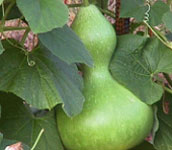
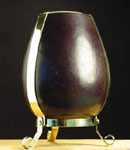
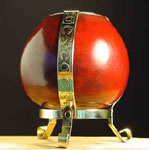
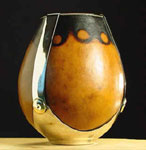
mate
de calabaza,
tökhéj színváltozatok
http://www.guayaki.com/yerbaMate/mateRitual/cureAndPack/curing
tipos de mate, matéfajták:
poro, porongo, pico porongo, mate de camionero, galleta, mates de metal, mates moldeados, mates retobados, mate de loza, mate de asta, mates de madera
GOURD CARE AND UPKEEP
1) Each time you are done using the gourd, it is recommended that you discard the used yerba mate in order to allow the gourd to dry and prevent too much mold from developing.
Wood gourds hardly ever develop the moisture mold. Traditional gourds, however, if allowed to remain moist for too long, will develop a natural mold. Often this happens during the curing process. Do not be alarmed, the gourd can be easily cleaned. NEVER USE SOAP. NEVER USE DETERGENT. The majority of yerba mate drinkers merely use boiling water to destroy the mold. The native yerba mate drinkers point out that the remains will discolor the gourd, but not make the gourd unusable. Indeed, some Latin Americans suggest that some of the benefits of yerba mate (specifically the reparation of the heart muscle) may be imparted by the unique mold that the yerba mate and the gourd combine to create. The idea that a mold could contain healing properties is not new; see (Fun Facts About Fungi).
2) Tricks to keeping a gourd dry in humid climates:
It may help to put a paper towel or napkin in the gourd after you use it. This will help absorb the moisture that may remain. This will become less important as the gourd is used/dried more often. It will tighten up and become more resistent to absorbing water.
3) How do I improve the longevity of my wood gourd?
Wood may crack around the lip of the gourd if the wood gourd is not used regularly. Rubbing Olive Oil on your wood gourd can contribute to making a wood gourd last forever. If you think your wood gourd is looking very dry, then do not be afraid to treat it to some Olive Oil.
Commissioned
by Argentina, ceramic maté-drinking ware was produced from the late 19th century
to the beginning of the Second World War in some European countries, particularly
Germany and Czechoslovakia. In the 1940s, Argentina established its own production
of such containers; however their quality was inferior compared to the European
output. (Collection of Ildefonso Suescun and María Dolores Benard de Suescun of
Argentina)
http://www.upm.cz/index.php?page=123&year=2007&id=85&img=848&language=en
Brazília
http://www.tribalbrasil.com/english/mate/tradition/chimarrao.html